John Greaves III's Blog, page 18
November 21, 2016
The Unconventional Bud Jeffries
Bud Jeffries is one of the most accomplished, yet controversial figures in strength sports today. As a performing strongman, he’s got to be ready to go any time he’s called on. Beyond that, Bud proudly lives what he calls the unconventional life, refusing to limit himself to anyone else’s idea of how to train. If you follow him for any length of time on Instagram as I do, you’ll see him boldly challenging any and all of his critics to match any of his feats or else be quiet. I had the chance to catch up to him to find out about his no rules training style and why he trains at home.
Best Lifts
Bud thanks for this interview. You’re an extremely accomplished strength athlete. I don’t even have space to write down all of it. Let’s start off by talking about some of your best lifts.
It all depends on how you quantify all of that stuff. I used to compete in powerlifting all of the time and then I kind of quit and went off on my own and that’s when all of my best lifts happened. And I’ll tell you why. I believe I stopped living under somebody else’s idea of what was the right way and started working what the right way for my body was.
Squat the types of squats I do are Anderson Squats, parallel start, bottom position start. My best ever is 1,000lbs.
Yeah, I know you have something out saying you offered $1,000 to anybody who could equal it? Yeah, years ago I offered $1,000 to anybody on the planet who could beat that lift and take a drug test. So nobody answered.
I was going to say that you still have your money as far as I know. Yeah, nobody answered; nobody tried. One guy was pretty close, I have no idea about the drug thing. And really that doesn’t matter to me that much but if we’re going to be straight about everything; it is what it is.
What’s your best powerlifting competition squat? About 800lbs. Actually I did about 850 walked out in a gym. I did 850 four days in a row, walked out in a gym. I wanted to experiment with different frequencies, trying to really see what the difference in effect it had on the body.
Bench My best ever bench in a gym is 500
Deadlift my best ever deadlift is 705lbs.
Overhead Press I did 350lbs from a dead stop seated. Starting at below my chin. I’ve also done between 200-220 one armed with a dumbbell, with a pair of stacked kettlebells or with a stone.
That’s the thing when you have someone who’s a performing strongman and you ask him what his best lifts are! Because you do so many things it’s not like you’re a single lift athlete. And there’s the thing, I wanted to get away from being a specialist. You know what I’m saying? In some ways you can look at is as I am a specialist; I am a strength specialist but I wanted to have an extremely wide variety of strength. Because I think one of the mistakes we make in modern lifting is we’re very narrow in our scope of things. Listen man, there’s a million legitimate ways to squat, to deadlift, to bench press, to press overhead, to pull things—there’s a lot of ways to be strong. One is not better than the other. It’s just what you want to do. What do you feel like doing? And within that you open up the framework to say, Okay, this really fits my body and this doesn’t leave me hurting. Which is two big questions to answer. So if I told you there’s only one way to squat, press, pull whatever—that’s the only legitimate way but that way doesn’t fit your body and it leaves you with destroyed knees or a hurt back or torn up shoulders but you could be legitimately strong in ways that don’t damage you; that you have fun with, that work in the real world and don’t leave you hurt; why wouldn’t you train that way? We try to make it like one of these ways is the king of the lifts. Listen that’s baloney. There’s a million ways to do it.
Click to view slideshow.
That’s one of the things I want to touch on a little bit before we go on. Zach Even Esh is someone I follow and he’s big on preparing for anything. Now you can’t really prepare for everything but it seems like training the way you do means if there was a powerlifting meet; squat, bench, deadlift, you could say, “Yeah, I’ll enter that” but you wouldn’t necessarily need to meet prep for it. You could just be like, “It’s this Saturday? Okay, I can do it.”
I mean I can walk up and do that with no problem. Now here’s the thing: I can walk in and do it this Saturday and you total whatever you total. Now you give me three weeks to practice the competition style; that would be an extra hundred pounds or more on the total. You give me six months—it’s a progression of how prepared I’d be. Now I can still walk in and give a very decent total; it’s a question of specific preparedness versus general preparedness. I’m just a bigger believer in general preparedness unless you’re trying for one specific thing and willing to try that at the cost of everything else or at the minimal importance of other things.
Training Philosophy
I have a very specific set of basics that I practice all of the time. Because I believe that’s when you are the most generally prepared. I don’t necessarily do the competition style but I always do some kind of squat, some kind of press, some kind of pull, some kind of balance movement, some kind of stone or odd object lifting, carrying, some kind of endurance movement and then some kind of agility based movement. Because I think those are the big things. If you can move well, if you can lift things in all the major physical movements, if you can pick up and carry lots of things. If you can balance, if your endurance is good, you’re pretty well physically prepared to walk in and say, do a powerlifting meet or do a Spartan Race or whatever.
What is the hardest thing that you’ve ever tried to do and failed at and how did you handle failure?
Terribly ha ha!
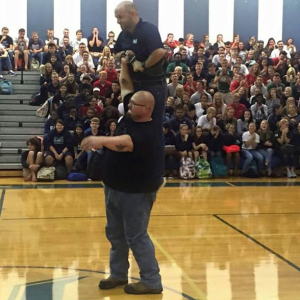 One arm pressing a teacher at a high school #antibullying assembly last year
One arm pressing a teacher at a high school #antibullying assembly last yearBecause the first time you squatted, you got mashed to the floor but didn’t quit. You got hit by a car and didn’t quit.
I usually handle it by repeating it over and over again until I don’t fail. First time I squatted 900lbs it took me four tries and I passed out on the second try! And here’s the thing about having a long term career sometimes we try things and it doesn’t go that day and we quit but I’m going to stick with it and try most things until I’m going to succeed. Now don’t get me wrong, I’ve built a lot of calm but I’ve also got a lot of rowdy that’s just sort sitting inside me. So if you see me miss a lift you may well see me jump up and down for a second and yell and scream. Scott Weech’s one of the strongest powerlifters in the world but Scott’s a very calm human being. Scott misses a lift and it looks like he spilled his tea! It’s a difference in emotional makeup or whatever. I’m very invested in the things I do to the point that I really, really want to do them. The hardest one I haven’t succeeded at I don’t know.
So maybe in your mind it’s you haven’t succeeded yet?
Absolutely.
I think that comes from your performing strongman background because I watched Bending Steel and Chris Schoek worked on that bar for months. I wrote an article about how the definition of work out used to mean it’s a problem to solve. Like working out a problem on the blackboard, a strongman is trying to figure out how to do x, y or z. And I guess when you look at it from that perspective failing now just means that’s not how to do it and I just need to figure out how to do it.
Absolutely and many of these things, they take months! Months if not years. It took me sixteen years to squat 1,000lbs. Sixteen years of training, it took me nine months to do a triple clap push up and a triple clap one armed pushup. Took me months and months and months to get them done. Took me months to be able to do a thousand swings in a workout. This is long term. In the first meet I went to I set four state records and I had a little interview in the local newspaper. I was fourteen so it was a big deal. The guy who was coaching me at the time who was one of the powerlifters who I started with said, “He’s done a very good job and now we’ll see what happens in the next ten or twenty years because that’s the game of strength it’s a long term progression.” And now I see it’s even longer, especially when I go out to see what there really is to explore, what there really is to try. There’s literally a lifetime, you could go a lifetime and still barely explore all of the ways that there are to be strong.
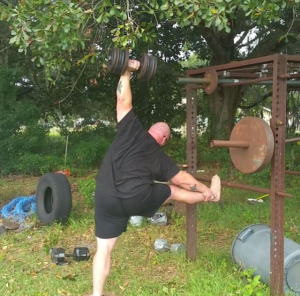 100 pound one arm dumbbell clean and press in ballet stretch
100 pound one arm dumbbell clean and press in ballet stretchYou train in your backyard like the legendary Paul Anderson. Is it because you simply have more freedom to train how you want or do you just like scaring your neighbors?
We talked about being ready for anything? So being ready for anything I also think is being outside. It’s being ready to function in different temperatures, different environments, different stimulus; I like to be outside. I think the oxygen is better, your connection to the ground and all of the health benefits is better. Also nobody’s in my way. I don’t have to wait for a pec deck. And because so much of my routine is experimental and super fast paced that most of my work is some combination of cardio and strength together so like I’m literally moving in a no rest fashion which is very hard to do in most gyms. Most people don’t have rocks to play with and they’re not going to let me light barbells on fire. I have so much more freedom here.
How can people get in touch with you if they want to purchase your products or find out more about your training?
They can go to my website: anunconventionallife.com and they can always catch me on Facebook, Instagram, Twitter under my name Bud Jeffries and there’s links to everything. If it’s crazy we’ve got a video to show you how to do it!
The post The Unconventional Bud Jeffries appeared first on Garage Gym Life.
November 20, 2016
Time To Rebel Against Black Friday
For those of you outside the U.S. (or anyone just emerging from a 20 year coma) Black Friday is the annual attempt by big box retailers to turn a holiday intended to celebrate all we should be thankful for, into a mad dash of pissed off soccer moms and suburbanites elbowing each other; trampling kids in an attempt to save 30% off something they don’t need. That is b.s.
Say No Go
It’s high time for a rebellion. I’m getting together with my brother, Boo (@uncleboo56), Randy Olson and a couple of other guys on Black Friday to train at Boo’s backyard gym. Not to show how hardcore we are, but as a celebration of the fact that we are ABLE to train, as an expression of thanks that we get to use our bodies in an activity we enjoy. It’s a rejection of the idea that I need to abandon my family after eating my face full and go stand in line for hours just to get pissed off that somebody else got the last whatever that does something that will be obsolete in six months.
I’m putting it out there that everybody who wants to rebel, not go shopping that day. Instead spend time with family and then at some point, get a training session in, by yourself if necessary, wearing all Black. Doesn’t have to be lifting; can be anything exercise related. Want to max out on push ups and post a pic? Go for it. Hill sprints? Do it. Go for an AMRAP on deads? Do it.
I’m sure somebody’s going to point out that since I don’t have a storefront, not shopping on Black Friday won’t hurt me. Whatever. You’re telling me that I’m not tempted to let the coupons and discount codes roll so that people who are at home are drawn to my site to shop while they’re coming out of a food coma? Really? That’s what you think? That a recently started small business in need of capital isn’t jumping at every chance to get more customers? Well, unfortunately for you, I started this last year, before I opened my business as something with other members of the Animal Barbell Club. Here’s the video to prove it.
As I was saying
If anybody asks you why you’re doing this, the day after Thanksgiving, tell them you’re sending a message to your kids that taking care of yourself is more important than more junk to clutter up your house, that you’re lifting to celebrate your gratitude that you have working arms and legs or simply to be grateful that you’re alive when so many others didn’t survive from last November to this one.
This isn’t limited to the U.S. either, anybody can do it, anywhere in the world because we all need to celebrate the simple joy of being alive and I can’t think of any better way to do that than to use your body in a way that our Creator intended them to be used. Moving. Just be sure to wear all black to train and record it in some way then share it with the world with the #BlackFriday.
Rant over. Welcome to the revolution.
The post Time To Rebel Against Black Friday appeared first on Garage Gym Life.
November 17, 2016
Home Gym Tip: Your Scale Is Lying To You!
Your scale is lying to you according to Anna Woods of sheSTRENGTH.com . She thinks (and I agree) that we’d be better off using other, just as simple ways, to measure our progress.
Don’t Tear Your Calluses
Roger LaPointe says manual laborers hold the secret of how to avoid the dreaded torn callus from heavy deadlifts, cleans and snatches. Check out the full article here and don’t forget to subscribe to the Garage Gym Journal so you don’t miss a single issue!
Your Buddies Will Help You Get Stronger
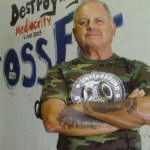
According to garage gym coach Frank DiMeo, we need a few trusted friends to keep us accountable, serve as spotters and even mentors on occasion. Read more at cavestrong.net.
Start Working On Next Year’s Goals Now!
Author and success coach Dan Miller says plan your goals for the next year by November 14 of the current year. He says, “That way, you can enjoy the 48 Days leading up to the New Year with the confidence that you know what you are going to accomplish in it!” Read more . . .
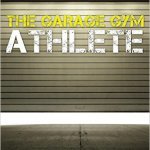 available on Amazon.com
available on Amazon.comPodcast of the Week: The Garage Gym Athlete
Author, Air Force veteran and Strength & Conditioning coach Jerred Moon is the guest on the Art of Manliness podcast where he breaks down his training system and gives all sorts of tips for creating a garage gym. He gives a ton of options including renting a storage space if you live in an apartment and talks about the insurance implications of having friends train with you in your garage. Click here to listen . . .
Hip Pocket Class: How to Clean Your Rogue Barbell
The post Home Gym Tip: Your Scale Is Lying To You! appeared first on Garage Gym Life.
Weekly Motivation: Tony Lewitzke Builds A Legacy!
Tony Lewitzke builds a legacy every time he goes to his basement. The corrections officer known as @_nido_roht on Instagram is a husband, father and strength athlete in that order. He’s competed in powerlifting, both raw and equipped, strongman and Highland Games. Despite that I think this is the most inspiring thing I’ve seen him do and I’ve seen a lot of his lifts. In fact, when I saw this video of Tony squatting in his basement gym with his son I immediately asked him to post it on Instagram. I was originally going to repost it on @garage.gym.life but I preferred to do it here because it certainly motivated me!
You Are Not Alone
I know that training in the garage by yourself is tough. You usually don’t have the camaraderie of other gym members to help push you. That’s why I combed the web to find videos like this one that will help motivate you to keep striving to be your best. Remember that there are hundreds of thousands of people around the world training at home like you and my mission is to connect each and everyone of us. Welcome to the movement.
Follow Tony Lewitzke on Instagram and until next week, stay motivated and keep training hard until people want to post videos of you!
The post Weekly Motivation: Tony Lewitzke Builds A Legacy! appeared first on Garage Gym Life.
November 14, 2016
Garage Gym Showcase: Al’s House of Shred
This garage gym showcase focuses on on Al’s House of Shred, a basement gym in upstate New York run by former powerlifter, Alberto @boricuabarbell Velasquez and his wife Danni. Every week, Al opens up his home to trusted friends every week as part of his personal mission to pass on what he knows. Let’s find out more about what’s going on up there in Syracuse!
Background
Tell me how your gym started? Were you already training in your garage and added people or did you all start training at the same time?
I’ve been competing in powerlifting since 1993; My own personal journey—
I was bullied by family and friends and I looked to the weights. And I sucked! It’s funny because I saw Arnold in Conan the Barbarian, I must have watched that movie a thousand times,
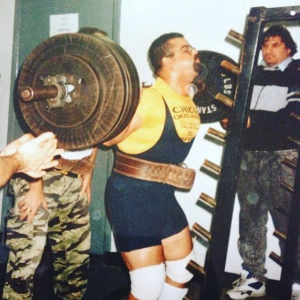 Alberto Velasquez squatting 500lbs circa 1994
Alberto Velasquez squatting 500lbs circa 1994Him pushing that wheel?
Yeah, and then I discovered Muscle & Fitness and I was like, “Man! These routines, I’m not changing!” But through Muscle & Fitness I saw an ad for Powerlifting USA and I saw Anthony Clark squat 1000lbs in the ad and I was like, “Wait a minute! This guy doesn’t look pretty but he’s strong as heck!” And I remember sending the envelope with the money order and I got my first issue of Powerlifting USA and I was like, “Holy cow!” And I knew right away there was a difference between training for strength and training to look good to impress other people, to try to fit into society and from there it took off. That’s how my journey took off. So the original Al’s House of Shred started in 1993 in a basement in Brooklyn. Training by myself twice a week I was able to get almost a 500lb squat and almost a 500lb deadlift. It was tough because I was doing it by myself in my basement. Then my career got derailed because I got hit by a car in Brooklyn that left me with permanent damaged right arm, separated shoulder, broken arm I never was able to reach my numbers again. But then, last February my health issues were out of control. Diabetes, high blood pressure, all of the stuff a middle aged male gets, I was very heavy and I was into powerlifting . The name of the gym was originally at the new place in my house, which I’ve been living in for two years now, The Fat Man’s Barbell Club. So I went on an extreme diet and at this point, I’ve lost 100lbs
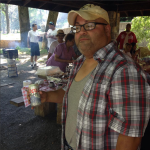
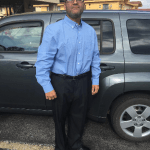
Oh, that’s what’s up!
Yup. Just eating low sugar, low carb diet, just cleaning up myself.
Eating like a grown up.
Yeah, eating normal; trying to regain my health even though I knew it was going to be at the expense of my strength; which I was fine with that. Then my buddy, Dave Wilson, Mr. Wilson or @strathmorebarbell, as a joke said, “You know you should probably call your gym now, Al’s House of Shred!” I said, “You know that sounds pretty good!”
This was like in early March, he was on and off of powerlifting; he wasn’t consistent and he decided after watching my transformation, “If Al could clean up his act what’s stopping me?” He sort of discovered that he loves powerlifting and he wanted to be consistent with it.
Then all of a sudden I had another buddy who was like I’m struggling; the kid’s a natural deadlifter and we’ve been trying to get him to lift for two years and he’s a CrossFitter but he’s built for powerlifting. And that’s Patrick, the Starfish. And we said, “He’s a natural deadlifter; a strong kid but he’s just got to refine his technique.” So then that’s the third member joined. Then my wife said, “I want to get back into it; so this is what we’re doing.” I decided to add a second platform, which is basically two horse stall mats, $40 a pop to protect the floor. Then all of a sudden, a kickboxing instructor named Matt Barnell wanted to join us ‘cause he was like; he felt weak; he’s a martial artist and he just wanted to get big and strong. So I said all right, let’s add a third platform. And then slowly a team started forming. All of a sudden we started building a bond, I got some t shirts made, Al’s House of Shred and people were interested in competing. I decided to do my last meet in April at a lower bodyweight and I just called it a career in lifting and I decided to concentrate training and coaching, mentoring the new powerlifting team that just came together.
If a brand new lifter wants to join the crew what’s your process? Because you’re really letting somebody into your home!
It’s funny that you said that. When Matt Barnell came, Mr. Wilson gave him the look up and down to see if he was serious. Because it has to be serious; it can’t be fun and games. It is called training. But after one or two sessions, Matt Barnell was serious and he said he wanted to be big and strong and he went under Mr. Wilson’s wing and he said, you’re going to listen to me and you’re going to listen to Al. And he was like, “No problem.” For somebody to join us, since we’re not a commercial gym, a stranger no. But a family member or if a team member had a buddy, I would be open. But a complete stranger, no I would not. We’re more like a club; I think that’s the best way to describe it. I think what ties it all together is the freedom of a garage gym and the love of iron.
Click to view slideshow.
So how many members do you have total?
I’d say no more than ten.
Are most of your members around the same experience and strength level?
I see down the road, Mr.Wilson squatting 500 easily. He deadlifted 500 already last August at an RPS meet.
I saw that, didn’t he beat your old record or something? Yeah, he beat my old record of 496, it was in kilos. Our records are personal records, we do it for fun. For our own personal goals. Patrick, he’s a natural deadlifter, he will be deadlifting 600 within a year.
And how much does he weigh?
He’s in the 275lb class. He could easily go up into the super heavyweight. Mr. Wilson is at a light 275lbs, he could lean out to 242 if he wanted to, Mr. Miyagi, Matt Barnell, deadlifted 440lbs weighing in at I believe a light 181. He’s the youngest one. He could probably go after some state records down the road. I’ve got Dave’s brother, another Matt, he’s strong. I’m trying to get him to enter a meet. I think he will enter a meet next year. I’ve got two coworkers here, one is rehabbing his knee through squats and the other one just wants to work on his squat. But the core of the gym is the powerlifting team.
The Set Up
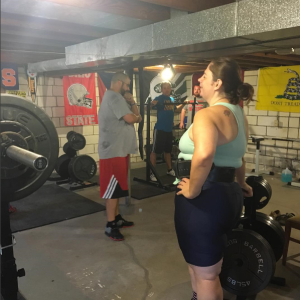 Als House of Shred morning squat session
Als House of Shred morning squat sessionIs this a pay to train facility or is it more of a barbell club made up of training partners who spot each other, give feedback on each other’s lifts and monthly dues to help cover expenses?
No none of the guys chip in. This is for me a personal thing for the love of the sport and for the love of helping other people reach their goals. No travel fund, we just share rides together. They split hotel costs for the rooms for a meet. One of the guys chipped in and bought some bumper plates so that helps too.
That’s cool. How many square feet you got?
Small house, I think it’s under 1,000 feet. Like 975 maybe.
You’ve got three platforms. How many racks and other workout stations do you have?
I was thinking of doing a short video for Instagram to show people what we’ve got. I have equipment for the guys so they won’t be surprised at a meet basically. Each platform’s got the York Legacy plates, good plates, got Rogue Bars, a nice heavy duty squat stand from, they’re not in business any more, Muscle Driver USA which is really heavy duty. I bought a heavy bench from Rogue with a wider pad so it’s more like a powerlifting competition bench; that helps out with the lifters. I believe it’s a competition height, I have a cheap one and the lifters can tell the difference. Then my B and C platforms I have squat stands which I can move them around and turn it into a deadlift platform. And then all of a sudden we have a Buffalo Bar by New York Barbell and that helps my shoulders now because of my shoulder damage, so I can low bar squat. And then we decided to use it as a bench press assistance and the guys love it for the bench press assistance, the extra range of motion. This is a funny story, I got a good quality B&R bar from Rogue and the guys like squatting in the Rogue Beater Bar which is only $200 but it’s a thicker bar so it feels better for the low bar squat.
How long did it take you accumulate all of your equipment? What did you start out with?
There was just a squat stand, a cheap Olympic barbell and a bench. My training partner was Powerlifting USA. There was no social media. My friends weren’t into it, there was nobody around. One of the highlights for me was I did my first meet and I bombed out and I didn’t want to quit and I just kept going and finally did my second meet and just kept going from there.
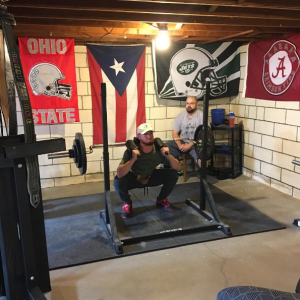 Mr. Miyagi testing out the new Safety Squat Bar
Mr. Miyagi testing out the new Safety Squat BarI know the process of acquiring equipment is never ending, we’re always finding new toys. What’s next on your “must buy” list?
I just added a Safety Squat bar; I may get a deadlift bar and I’m shopping around; one of my Instagram friends suggested a power rack which I may get. Not sure at this point.
Where do you like to get equipment now?
I narrowed it down to two outlets: EliteFTS or Rogue. New York Barbell is another one, I drive down to Elmira to save on shipping. But I believe if I’m going to train guys for powerlifting, I save up so I can spend the extra money to buy stuff.
The Schedule
You’ve got to work around work schedules and make sure that training doesn’t impact your time with your wife while at the same time making sure your lifters get enough time under the bar during a session and enough sessions per week to improve.
For me training day is Sunday and that’s why we chose Sunday. We lift at around 9 o clock and we usually get done by 11 so we’ve got the rest of the day. Al’s House of Shred only runs on Sunday for the most part. The program basically runs on Sundays here, squat and bench and assistance work for those two lifts. On Tuesdays at Strathmore Barbell, it’s a smaller space. He lives in an older house so the male lifters overhead press in his garage and Thursdays they deadlift in his basement. So basically it’s a three day training week.
Yeah, you’re actually set up with a sister gym, Strathmore Barbell. How does that relationship work? Is it a case of going where the equipment is or a scheduling thing?
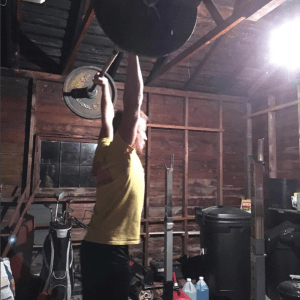 Overhead Press at Strathmore Barbell
Overhead Press at Strathmore BarbellAbsolutely a scheduling thing. Dave is sort of like my unpaid assistant head coach.
When they go over to Dave’s do you still go over there with them?
Yeah, I sometimes go there to coach and to watch them lift and see their technique. Dave’s a very excellent teacher. We bounce a lot of ideas off of each other. He’s a very, I call him the Cerebral Assassin, he thinks a lot. He’s got down the road, looking to become a certified Starting Strength coach. We both have a passion for this.
It’s great because it reminds me of my old basement in Brookly, it’s a very dingy looking basement; and they blast the metal and rap and they just train away.
So my wife is conditioning, kickboxing three times a week and she lifts three times a week. If one of the guys can’t make a regular day at Strathmore Barbell and they want to deadlift here, I’ll let them deadlift here. It’s a little bit flexible. If it was a perfect world, I’d have everybody squat three times a week but it’s not a perfect world, everybody’s schedule, jobs, families are different so the 5/3/1 works out perfectly.
Okay, so your wife is lifting three days a week and the guys are training once a week at your place and the three days at Strathmore. So are the other two days the days you train with your wife at home?
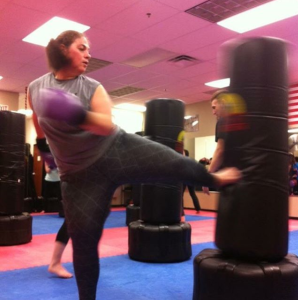 Danni enjoys kickboxing along with powerlifting
Danni enjoys kickboxing along with powerliftingI don’t train with her at home. She trains on her own. I just write out her program. She’s at a point where she can do it on her own with just one basic lift. Being an older lifter, she’s in her late forties, with her I don’t push no volume unless it’s assistance exercises. So for example if the set calls for one set of 240 and this is based off of 5/3/1, I say squeeze out another two or three reps but I don’t push volume because of her being an older lifter and she already does kickboxing three times a week. And with 5/3/1 being so flexible, I can cut out one day if she gets too beat up or increase it if she’s on the money.
Training Philosophy
You guys use Starting Strength and Jim Wendler’s 5/3/1 which are both very popular training templates and training philosophies. How do you integrate the two?
For personal equipment, everybody lifts in Olympic weightlifting shoes , I tried it out myself and I can see why Starting Strength pushes it a lot. I had my lifters train in Chuck Taylors but since we lift raw the conclusion is Olympic lifting shoes works perfectly for the raw lifters.
So you do that for ankle flexibility?
Ankle flexibility and there seems to be a lot of power out of the hole with the foot beign so stable in an Olympic lifting shoe. For example, Matt Barnell, my lightest lifter, he competed last April in Chuck Taylors then he got a pair of weightlifting shoes and he could just tell a difference in the power and how he is stable coming out of the hole in the squat. Doing the deadlift in a heeled shoe, it seems to activate the quad, and I tried it myself, so it feels like you’re pulling the bar faster to lockout. And with a heavy deadlift, for some lifters, the faster you pull it off the floor the better your lockout. That being said, I grew up with lifters lifting in Chuck Taylors or some type of flat shoe so you can get strong either way
I myself when I started lifting; remember this was the early 90s, there was no Internet to find information or anything like that; I high bar squatted because that was the natural way to squat because there was no information out there. I didn’t know about low bar squatting until recently. If you get strong with either style that’s fine. I chose for the team the low bar squat based upon the teachings of Mark Rippetoe’s Starting Strength. And I’ve seen that it works. High bar, does it work too? Yeah! But for everybody here to be on the same page for powerlifting, we choose the low bar. We chose 5/3/1 program for the simple fact of scheduling and we just found that 5/3/1 is more flexible for everybody’s schedule.
Do the lifters get to choose which protocol they follow or do you create their weekly training plans? Like is everybody doing say Boring But Big or does everybody do their own version of 5/3/1?
That’s my three male lifters: Dave Wilson, Matt Barnell and Patrick Vinette. At this point, they were doing 5/3/1 Boring But Big and I believe the next cycle they may change it. The Boring But Big was basically to have a lot of volume and to teach the body the motor patterns of the three powerlifts. The next cycle they’ll bump up the percentages of Boring But Big and then the next cycle they may add more variations of the powerlifts. So for the back squat they may do front squats or pause squats, bench press will be close grip and deadlifts will be either stiff legs or deadlifts off a platform.
Do they do Joker sets also?
I believe that’s coming up but not yet. The foundation of the team is 5/3/1 with different variations. I think it’s the perfect balance. For my wife, she does the basic 5/3/1 for the deadlift and for the squat and bench 5×3 varying progression because she’s new to the bench and she’s new to the squat. And we use the trap bar for her to get more volume in the squat and we use the box to judge her depth being a new movement.
I know that you guys are a tight knit group; I always see you guys cheering each other’s lifts on. How did you build that team pride and sense of loyalty?
You know you read about Westside Barbell, the Westside team and how great they are. I read about Hercules and how they travel as a team other great powerlifting teams I read about and I see how with a team you get better. If you lift with people stronger than you, you will get better and I see my lifters get better from being in that team environment. The team started to build that bond because everybody had that bond it was kind of weird because everybody had the same goal, get stronger, to improve themselves. And my wife likes it. My wife likes the physical changes, I think she was afraid that she had to look a certain way because of society so when I showed her the pictures of the female lifters on Instagram who I follow, I think she felt better about herself and realized that society’s got it wrong. We’re a small niche but we’re like an important niche. I’m not crazy about CrossFit but I respect CrossFit and I recognize that there’s a difference between a regular, weekend CrossFit warrior and CrossFit the sport. I do read the articles especially about the nutrition, because as somebody who coaches, I try to learn from different disciplines whether it’s bodybuilding, I try to read Animal’s articles, stuff from Louie Simmons. I try to read so much about lifting in general, how to apply it to my team. My goal of House of Shred is to give back to the sport I love, the sport that taught me a lot about life.
Chemistry is so important to a successful team environment. How do you handle it if you have a lifter with a toxic attitude regardless of strength or experience level?
I can tell you this from experience; I had a woman train until recently that, she was becoming a distraction. I think she wanted to lift but not lift for the sake of lifting. I was like that doesn’t work when you’re trying to lift for strength so I basically told her, look you have so many other activities going on, you don’t eat right, you don’t sleep well. You need that. So I told her, “If you’re very serious about this, there’s a couple of places to go, one is with a Starting Strength coach, another one’s Hercules Gym.” She checked them out and eventually she decided to stop coming here. So that’s the way I handled it. And then from there I said to myself, I’ve got to be very selective about who I let come here. Because if it doesn’t work out then you’ve got to be delicate about telling them it’s not going to work out.
Which federations and sports do you guys compete in? Is everyone strictly a powerlifter or do you guys also compete in other sports?
We decided to do two meets a year, August is the RPS meet in Buffalo, NY; we enjoy the RPS so that’s our main meet where we do all three lifts. In April we go to a little AAU meet and we do push/pull. And now this February, we’re going to do a three lift meet right here in Syracuse, at Hercules Gym promoted by Rita West. Just to get the newer guys more experience, test the training cycles. My goal, since I don’t compete no more, is to just share my knowledge and give back to the sport. I take personal pride in the guys hitting their personal records and I’m extremely proud of my wife lifting.
Parting Advice
What advice do you have for someone else who’s thinking about opening up their garage gym to the public or even letting friends come train with them?
First of all what type of lifting discipline are you using? Are you powerlifting? Are you bodybuilding? Are you doing CrossFit? Are you doing Olympic lifting? But if you’re doing any of those, your best course of action is a good quality power rack. And the number one reason for a good quality power rack is, if it’s just you lifting, safety reasons. You miss a bench, you miss a squat, you’ve got the pins there. And get one rated for 500lbs or more. A top of the line EliteFTS rack. After that, a good quality bar and then for plates, you can get them used. Craigslist, Amazon. If you’re going to do the Olympic lifts mixed in with powerlifting, you need a good set of bumpers. That would be my advice. No question about it, Starting Strenght is the foundation first and then once you pass the novice stage, there’s plenty of those programs. Brandon Lilly has The Cube, you could toy around with Westside but I always believe whether you’re bodybuilding or powerlifting, you’ve got to get the basics first and those are sets of five in the deadlift, bench and squat. In my opinion, the squat’s the foundation. Because as a lifter, back in the day, if my squat went up, my bench and deadlift went up. And you know, I didn’t realize this at the time but the squat and deadlift trained the same muscles.
Well you know guys like Dr. Ken Leistner were huge proponents of high rep squats!
Dr. Ken Leistner was one of the guys I read back in the 80s. Long Island, used to own Iron Island Gym. I had my first meet there, which I bombed but it was a valuable lesson. The people I read about the authors, were writings by Dr. Ken, I used to read articles by Stuart McRobert,
Oh yeah, his book, Brawn changed my life.
I still have my original copy. And believe it or not, I bought the first version of Super Squats by Randall J. Strossen, I bought that in 89. Brawn I still got my first copy. I bought Hardgainer Magazine. And even today we go through, the Steel Tip by Dr. Leistner, Stuart McRobert, Bradley J. Steiner, Mark Rippetoe, Marty Gallagher. All of those authors stressed the compound lifts. They all stressed recovery. And I realized myself, once I stopped training five days a week, started training two or three days. I cut down my training, I got stronger. A lot stronger. My basic program, again training by myself in my basement was I squatted and benched Mondays, Thursday I deadlifted. That was it and the rest of the days, I tried to recover, sleep well and eat good. And with that training , I pushed my squat up to 500lbs in a single ply suit and 480 raw and I got my bench up to 320. My deadlift was 496 it was in weird kilos. The programs were simple and they worked. I read about Louie too and I think Louie’s Westside system works I personally wouldn’t know how to run it unless Louie was there. Obviously it works, the gym speaks for itself. I watch Mark Bell’s SuperTraining, lot of great info there. One of the biggest highlights was we went to The Arnold back in 2012 and we were in heaven! We met Stan Efferding, The Rhino . . .
He’s a nice guy. I‘ve only met him once but he’s an extremely nice guy.
We met Scott Cartwright, we met Ed Coan. We saw Brad Gillingham hookgrip 800lbs. We saw a blind lifter from Trinidad deadlift over 600lbs. It was awesome.
What about the advice for someone considering letting someone else train with them?
Well you have to consider, have you hung out with this person before? What are their goals? If you’re a powerlifter and he wants to just look good. Little things like that, I guess the best advice is you’ve got to go with your gut. If your gut tells you this is not going to work out then don’t do it. And me and Mr. Wilson, we don’t charge anything; we’ve had coworkers ask for help but they don’t follow through so we don’t push it or anything.
 I’m a big follower of The Art of Manliness and I listened to a podcast from them about The Rise of The Sufferfests and why that’s happening. I think it’s because most people in our culture aren’t challenged physically. We’ve got the War on Terror but most people aren’t involved in the War on Terror, they don’t have physically challenging, fulfilling jobs so I think as humans we’re designed to overcome challenges and that’s why I think that what you’re doing is huge.
I’m a big follower of The Art of Manliness and I listened to a podcast from them about The Rise of The Sufferfests and why that’s happening. I think it’s because most people in our culture aren’t challenged physically. We’ve got the War on Terror but most people aren’t involved in the War on Terror, they don’t have physically challenging, fulfilling jobs so I think as humans we’re designed to overcome challenges and that’s why I think that what you’re doing is huge.
I’ll use Dave Wilson as an example. He’s done deadlift training on some nights after doing a 12 hour day, but he has to do it. It’s that inner, it’s that thing inside of you. He wants to get better, he had a goal. He wanted to deadlift 500lbs. Most guys I know wouldn’t do that! I had to battle personal demons because I had given up on life earlier. That’s why I was morbidly obese. I had a drinking problem. The doctor tells me, you’re eating yourself to death. I shouldn’t live to eat, I should eat to live and once I changed my mindset, I dropped 100lbs. It’s the balance of yin and yang as a lifter. And I reached some goals as a lifter. I squatted 500lbs in a single ply suit back in 1994, I almost had a 500lb deadlift but it is what it is. And I think when I got hit by a car, maybe God had a plan for me. I should have been dead. I think that there’s a bigger plan for me and that’s training my wife, that’s helping Mr. Wilson reach his goals, helping the Starfish, Patrick Vinette reach his goals, Mr. Miyagi, my youngest lifter, reaching his goals. It’s helping my coworkers and that’s the purpose for me. Is to help people, to help them understand. I have to keep active, if that means just lifting once a week and walking, well then so be it.
The post Garage Gym Showcase: Al’s House of Shred appeared first on Garage Gym Life.
November 9, 2016
Finding Mentors
Training at home is a solitary pursuit. Finding mentors is often the last thing we think of when we get into training at home. We pick our own program, we set up the exercise area to fit our needs. We choose the music etc. That’s a big part of the allure. But it’s easy to go off reservation when you train by yourself. Dan John may not have been the first to say it, but he’s the person I heard say, “If you coach yourself, you have an idiot for a client.” That sounds harsh but it basically illustrates how difficult it is for most human beings to examine themselves honestly, neither being too harsh or too easy on themselves; and then know how to correct the issues impeding progress. That’s where a mentor comes in.
Who Do I Trust?
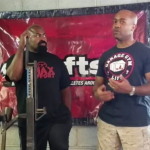
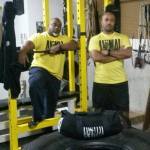
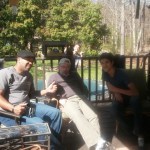
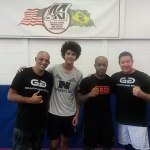
I have a circle of experts in every field who I turn to for help and advice. That ranges from appliance repair to deadlift programming. I’ve been a fan of this way before The Art of Manliness told me that every man should have ten people in his Rolodex. For those of you born after 1990, a Rolodex was a paper contact list men and women kept on their desk. Barbaric I know. Anyway, here’s my list of gurus I turn to.
Panel of Experts
Self Defense Chet Blalock comes from a diverse lineage that can be traced back to Bruce Lee and the Gracie Family. He’s trained with Joe Lewis, the man voted as The Greatest Karate Fighter of All Time by Black Belt Magazine, Richard Bustillo, Dan Inosanto, “Judo” Gene LeBell who may be the only person to be able to say that he’s choked out both Steven Seagal and Bruce Lee. More recently, he helped train Ronda Rousey. Chet has set the bar high for every other coach I have because he’s able to switch seamlessly from student to teacher and because he’s not a jealous coach. Many instructors get nervous when someone else wants to teach their students. Chet invites in and aligns himself with world class martial artists like Jiu Jitsu maestre Allan Goes without fear. He’s first on this list because he’s one of only two people who has risked his life for me on multiple occasions. More than a coach, he’s family.
Accountability This to me is huge. Training alone means there’s no one really to notice if you start missing workouts, or getting shaky with the nutrition. My brother, Brian Pankey, owner of a backyard strength training ministry called Pankey’s Athletic Training fills that role for me. We’ve been talking about training for almost twenty years, well before my parents adopted him as a son, and we’ve developed a rapport that allows us to complete each other’s sentences. He’s seen me at my best and worst and there’s no one else who could tell instantly if I fell off the fitness wagon. He also serves as an additional spiritual counselor as I do for him. One additional perk: Boo has been working in the electrical powerline industry for 18 years. He’s a tinkerer. So he’s my go to person when I need to figure out how to rig a piece of equipment to do an exercise. We even share equipment thereby doubling our shared stock. I could go on and on but bottom line he’s an invaluable resource for me. And he’s the other person who’s put personal safety aside as we fought our way out of more than one bad situation making him a no brainer as well as the first option when I wanted a godfather for my youngest daughter.
Weightlifting – Steve Goggins started out training alone at home with a weight set he begged his mother for. Fast forward a decade or so and he became the first person to squat 1102lbs. Today he coaches powerlifters in his garage gym and online, turning ordinary people into strength champions. Steve is who I go to when I need to fix technique or I have a question about improving any of my lifts. Training in his garage, I also run across a cross section of people with different approaches and solutions to problems. I don’t always agree with his grumpy behind and he teases me nonstop about politics but all I needed to see was how he treated my son Juaquin and I became a Steve Goggins fan. (But I’m still not competing in single ply.)
Spirituality Author/teacher/missionary Brad Martin and former therapist, Pastor/Church Planter Jody May. Yeah, there are two names here but I believe Proverbs 11:14 which says “Where there is no guidance the people fall, But in abundance of counselors there is victory”. Brad was the first person to orient my thinking to seeing the entire world from the standpoint that God uses everything to encourage relationship between us and Him. Jody is my current pastor and a fellow garage gym athlete. We have many discussions about manhood, spirituality and how God speaks to us through exercise sessions.
Appliance Repair Anthony Anderson is my neighbor. His 12 year old son has lifted weights in my garage since he was in elementary school. Anthony has several years of experience in the heating and air industry and he’s the first guy I call when something goes wrong in the house.
Car Repair Mark Newsome. Mark is another neighbor of mine who was a master mechanic for 20 plus years before injuring his shoulder. Mark is the person I go to when I need a recommendation for who to use to fix x, y or z on my cars. I still remember when one of those oil change places tried to tell me that I had an engine oil leak and I went to Mark for a second opinion. Mark sprayed the oil from the bottom of the car with a water hose and saved me over $1,000.
Currently Accepting Applications For
I’m still looking to develop relationships for business and marketing advice, and a barber to discuss the care and feeding of my goatee would be nice. Not because I can’t listen to podcasts or look stuff up on my own. Of course I can. But there’s nothing like sitting on somebody’s front porch and going over a problem with them until it’s no longer a problem; just a shared memory. The relationships I’ve developed over the years make my garage gym life possible. I don’t need the emotional crutch of having a crowd around me at a commercial gym. Just key people I can turn to when necessary.
Welcome to my garage gym life. By the way, this works both ways. I mentor several young people, two on a daily basis and others as they contact me. If you’re interested in a practical way to mentor young people, I recommend With: A Practical Guide to Informal Mentoring. by Alvin Reid and George G. Robinson. It’s available on Amazon.com in Kindle or paperback.
The post Finding Mentors appeared first on Garage Gym Life.
November 7, 2016
Strong and Bendy; A Thug Gets Mindful
Mindfulness and yoga go together but thug? Marisol Swords is a homeschooling yogi who balances that with a love of lifting heavy iron! Granted mobilitywork is fairly popular among lifters but it’s still rare to find someone as passionate about yoga as they are about weights. So I jumped at the rare chance to interview this Peru based garage athlete who walks effortlessly between both worlds! Plus I had to find out where the Instagram handle came from right?
Marisol, I appreciate your support for Garage Gym Life especially your willingness to talk about your yoga practice. I know that it’s an very personal part of your life but given how many misconceptions there area about it, I’m glad that you’ve made yourself available to talk about it.
What’s the significance of your name mindfulyogithug? How did you get it and who gave it to you?
I can’t help but laugh. I am a very private person, and when I chose the name I never considered having to explain it to anyone, so I’ll do my best. Mindfulness is a major part of my daily yoga practice. Its the yoga that we do when our bodies aren’t bending on a mat. I used to teach it to students at an international high school here in Lima.
Yogi because I am yogi. I’ve been practicing yoga for a majority of my life, beginning with my father in his dojo while growing up in the Bronx. My yoga has taken root in my life off the mat as well, because yoga is much more than just contortion and stretch.
A thug is an outlaw, hooligan, someone choosing to live outside societal norms. The word also has multiple significances to me personally. I grew up constantly fighting either my sisters, bullies, or watching battles of those around me. Violence and crime were major components of my childhood experience. Growing up in the Bronx, no matter how good of a person you wanted to be, you had to be a bit of a thug to survive. Now that I’m grown and learned a few things about the world as a whole, I choose to be as kind and compassionate as possible. But in a world full of every man for himself, unconditional kindness is an outlaw ideal. Purposefully choosing a peaceful life of love and kindness, by my logic, still makes me a thug.
a bit of a thug to survive. Now that I’m grown and learned a few things about the world as a whole, I choose to be as kind and compassionate as possible. But in a world full of every man for himself, unconditional kindness is an outlaw ideal. Purposefully choosing a peaceful life of love and kindness, by my logic, still makes me a thug.
I used to drive a school bus. My middle and high school students would call me a peaceful thug sometimes because I looked tough, sounded tough, and I’m from the Bronx but I was sweet to them. I fought my battles with logic and calm and that impressed them. So I figured why not exhibit a bit of my own duality in my IG name. I am mindful. I am yogi. I am thug.
How long have you been training and what made you start training in your home? You’re currently overseas is that why?
I have been training in my home since the day I was born, literally. My parents had a townhouse with a basement in the Bronx and my father was (and still is) a skilled martial artist and instructor. Dad always had a free weight gym in the basement right next to his fully functioning dojo. He taught gung fu and martial arts almost daily in that basement, and we attended almost every session. He started training us as soon as we started walking. I had never seen the inside of a commercial gym until I was twenty years old, so I honestly believed training at home was the norm, and Globo Gyms were odd.
You were absolutely correct to believe that by the way!
I never really got into the swing of going to a GYM GYM to do my training, I always found a way to get things done at home. Its how I was raised. That aside, gyms here in Lima are not my cup of tea. People already stare at me everywhere (I am a foreigner and I stand out with all these tattoos), and gyms are no exception. I am more comfortable and therefore more effective in my training when I train at home.
Which strength sports do you train because although it looks like you don’t shy away from trying new things like pole dancing or Olympic lifting, it seems like your main two pursuits are yoga and powerlifting. Is this correct?
Lol! My main activities are yoga and powerlifting. I still practice martial arts at home, but not like I did when I was a little kid. Believe it or not, the pole dancing was something my sixteen year old begged me to try for months. I finally gave in. And Olympic lifting is just for fun, its nice to see what this body can do.
Yoga seems to be equal parts instruction and self-discovery. Do you find that training at home helps more with one or the other?
Yoga is all self-discovery. Almost everyone (including myself) starts their practice focused on the physical part (asanas), then slowly realize that yoga is a life long journey of discovering not only who we are, but more so what we are not. Training at home helps me to focus my efforts inward, motivating me from within.
However, I am an academic person who is never afraid to admit when I need instruction beyond what I can teach myself. So when I feel I’ve hit a wall or plateau, I seek guidance. I try to stay humble knowing that I can always learn more.
I saw a post where you were practicing yoga and you said that it was because you’d had a tough lifting session. Besides physical recovery, how does yoga practice help you as a lifter and as a person in general?
The way yoga helps me has changed over time the more I’ve practiced. My practice began because my dad wanted to make sure we were flexible martial artists. Then it became what helped me lose 100 lbs after a difficult high risk pregnancy. Somewhere along the line, my yoga practice stopped being about the physical benefits and became about my minds ability to gather itself from the shattered pieces of a hard day. It became about how savasana was the only time I could ever experience true quiet, and it was rejuvenating. As my time on the mat became more inwardly focused, my time off the mat became filled with greater patience for people and things and an increased ability to successfully deal with my own stress and anxiety. I learned that I can still be honest and sassy without being hurtful and mean (I used to be a very miserable person, yoga helped change that too).
As far as lifting, I started taking lifting seriously in January of this year and I achieved quick gains because of my established flexibility and range of motion. In that way, yoga makes me a better lifter.
You said in an Instagram post, “I’ve been a yogi so long that when I get to the bar I forget to act like a lifter,” could you explain that and describe how you deal with it now that you know that about yourself?
My introduction to yoga was at about nine years old. Through adolescence and adulthood, I’ve always done yoga and martial arts; those have always been my sports. Due to my highly mobile life, I have to consider the transportability of activities. A punching bag is much harder to transport than a yoga mat, so over time, yoga became my main activity. Yoga makes you strong, but nothing makes you as strong as weight training. I wanted to improve some of the more strength intensive yoga poses, so I started lifting. I’ve watched all kinds of people set up for their lifts. Its all explosive and loud and filled with grunts and screams that sound like something out of an action film. My set up for everything is yoga based. When I set up for deadlift, I prepare with mountain pose and chair pose. When I set up for squat, standing back bend and down dog variation on the bar. While learning how to lift, I related all movements back to my yoga, so my lifting became a type of “yoga” practice of its own. I don’t really try to fight it, I let it be. Its the organic path my lifting practice has taken, so I roll with it.
One of the things that keeps lifters from stretching in general, never mind doing yoga, is the perception that it makes you weaker. There is some research supporting this which is why many strength coaches advise dynamic mobility rather than static stretching. How do you balance out your yoga practice and your powerlifting training?
I balance out my yoga and my lifting by changing yoga style. For warm ups, I like to do ten or fifteen minutes of some vigorous, heat producing power yoga flow. Flows keep you moving; so there goes your dynamic mobility. After my training, I switch style to some yin yoga or Iyengar with the long holds and props. There is a yoga style for every thing.
I hope lifters can look at super yogis like Kino McGregor, who has never done a back squat or a bench press in her life, and realize that yoga breeds strength, without hindering it.
I see several pictures of you squatting and deadlifting on what looks like your back deck. Is that where your gym is?
Yes, my gym is in my backyard overlooking some very beautiful greenery. It makes for a very peaceful lifting environment. Even when my dogs are running amok and my cat is stuck in the tree.
What are your best numbers in the gym?
Squat: 135 1RM
Bench: 90 1RM
Deadlift: 145 1RM
I have no idea if that is a lot or a little, but I know that all of those lifts have more than doubled since I started lifting in January. We all start somewhere right?
Do you intend to compete?
No. I have zero desire to compete. I am a person who loves a sport for the simple fact that my body is capable of performing it. I have no desire to see how I stack up to anyone else, I’m happy just doing my thing.
What did you start your gym with and what do you have now in your workout area?
My current gym started with one five foot, thirty pound training barbell. That was my first squat, bench and deadlift weight; and I struggled with it! It didn’t take long before that thirty pounds felt light.
I currently have a power squat cage, two seven foot Oly bars, over 300 pounds of bumper plates, a bench, variety of dumbbells, a yoga swing, gravity trainer and my newest addition: a barbell landmine. And that’s just what I keep in the training area. I’ve been collecting gear for years, the rest is scattered throughout the house.
Speaking of equipment, tell me about your yoga wheel, how is it different from using a foam roller?
A foam roller is for foam rolling only really. A yoga wheel can be used for rolling, but it gets pretty tricky to balance on it after a while. Mainly a yoga wheel is used to assist and enhance range of motion in a yoga practice. And people like to do really cool tricks with them. I’m not one of those people! I play it safe, lol.
What’s a normal training day for you? Seems like you’ve got the mobility and strength side of things covered. What do you like doing for conditioning?
Stairs. I like running up and down stairs. There are two separate flights of stairs with about twenty steps in each in my home. I am a stay at home mom with a homeschooled teenager, I run up and down those steps a million times a day aside from training. A normal training day consists of morning meditation, power yoga for warm up, about an hour to ninety minute powerlifting session, then cool down yoga and more meditation. My teenager often lifts with me and participates in the yoga, but opts out on meditation. For cardio, I go to my local CrossFit box and let them yell at me while I do burpees or I run laps up and down the stone steps near the mountain up the street from my house. Living on a mountain range makes finding challenging cardio as easy as walking outside.
You said that yoga helps build mental discipline but as a yogi is there a tension between being calm and centered and trying to get tight and fired up for powerlifting?
No, not really. As a yogi, I understand that all things possess duality: the idea that contrasting aspects can coexist. I also understand that while I may be hyped for lifting in that moment, when I am done lifting, I am done. The moment of hype has passed and the moments of calm have arrived. If anything, being able to have lifting as an outlet for that fiery energy supports my efforts to maintain a calm center.
How is your family involved in the different aspects of your fitness lifestyle?
My husband has always known I’m athletic, I mean a five foot two Puerto Rican ninja is hard to miss. But for the most part my family participates in many of my practices, at their own levels of course. My husband enjoys the yoga aspect of my practices the most while my daughter prefers lifting, attending the local CrossFit box as well as learning to power lift with me at home. Overall, we have always been a pretty active family.
Are you familiar with Natural Movement and have you tried it?
I was not familiar with it until this question here. Thanks to Google and YouTube, that has been fixed. Lol. No, I have never tried it, but if I am ever in a city that has a workshop or studio for it, I will most definitely be going. That looks right up my alley.
What’s the biggest misconception that people have about yoga? Or to put it another way, what do people ask you all of the time when they find out that you practice yoga that you wish they’d stop asking?
“I would do yoga, but I’m just not that flexible.” or “Do I have to be flexible to do yoga?”
I wish people would stop and really listen to the absurdity of the above statements. You don’t need a flexible body to do yoga; you need a flexible mind. When I hear people tell me this, I have to bite my tongue because anyone’s biggest obstacle to anything that seems impossible is whether or not you can convince yourself you can do it. Same with yoga. So the real question becomes: what are you afraid of? Most people want to do well at things, especially athletes who are accustomed to being the best. Trying something that might expose an area of weakness in them doesn’t hold high on their to do list. I find myself explaining to people that yoga is not a competition sport about who can get the bendiest. You start where YOU are, and with steady practice, you improve. Internalizing this concept is where mental flexibility comes in handy, you learn to let go of the idea that we are in competition with one another and come to understand that we are all having the same shared experience.
Are you into music while you train or do you prefer natural sounds regardless of what type of training you’re doing?
I almost never use music while I train and when I do, its gangsta rap. When I train, whether its yoga or lifting or martial arts, I tune out all activity around me and focus on the movements. So, whether I have music playing or birds tweeting, at some point I don’t hear it either way.
Occasionally for yoga, I will play thunderstorm sounds. It never rains here in Lima, and I miss the sound of it so much I play it during practice, it helps with meditation sometimes.
Powerlifting, even raw powerlifting, lends itself to specialized equipment, knee sleeves, heeled shoes, wrist wraps while yoga is practiced barefoot. Because of your greater mobility do you find that you can dispense with all of that?
No. Not just no, heck no.
Knee sleeves for lifting are just smart, human knees aren’t meant to support so much extra weight. So are wrist wraps and heeled shoes for squats. But with yoga, you’re not adding any weight the body is not already used to carrying, so no special gear is required. Also with yoga, you want to be in full contact with the surface on which you practice. Yogis have nice, mystical explanations for why, but I am a huge fan of science. Having your full foot in contact with your practice surface allows you to take advantage of Newtons Third Law: for every action there is an equal and opposite reaction. As you push your feet down into the ground, the ground pushes back up into your feet providing greater stability in standing poses. Kinda like when you dead lift, you want flatter shoes so you can push the floor, well, when you yoga, you wanna be able to push the floor and feel it push back.
As a yogi, I can practice with nothing but the clothes on my back, but as a lifter, knees sleeves, wrist wraps and lifting shoes are my desert island essentials.
Do you find it ironic that so many people shy away from yoga because of the religious overtones while not realizing that they already do a lot of the poses when they stretch anyway?
I do find it very ironic, and even kinda funny. I chuckle because practicing yoga asanas does not indoctrinate you into a new religion. And while many people practice the full eight limbs of yoga as a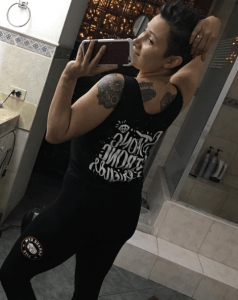 spiritual path, it would still be considered a philosophy, not a religion. And you can literally hold the beliefs of a philosophy to be true AND still be devout to a religion, especially when the principles of both support one another. My father is an excellent example. He was raised, as are most Puerto Ricans, as a Roman Catholic. He became a martial artist and Buddhism became a major part of his life philosophy. If you ask him, he will tell you he is a Christian Buddhist. He finds zero conflict in this dualistic designation.
spiritual path, it would still be considered a philosophy, not a religion. And you can literally hold the beliefs of a philosophy to be true AND still be devout to a religion, especially when the principles of both support one another. My father is an excellent example. He was raised, as are most Puerto Ricans, as a Roman Catholic. He became a martial artist and Buddhism became a major part of his life philosophy. If you ask him, he will tell you he is a Christian Buddhist. He finds zero conflict in this dualistic designation.
Regardless of why people do or don’t practice “yoga”, as long as they are doing the moves and feeling the flow, and maybe even gaining some calm, they can enjoy it under whatever name they like.
You can follow Marisol on Instagram @mindfulyogithug
The post Strong and Bendy; A Thug Gets Mindful appeared first on Garage Gym Life.
A Thug Getting Mindful with Yoga?
Mindfulness and yoga go together but thug? Marisol Swords is a homeschooling yogi who balances that with a love of lifting heavy iron! Granted mobilitywork is fairly popular among lifters but it’s still rare to find someone as passionate about yoga as they are about weights. So I jumped at the rare chance to interview this Peru based garage athlete who walks effortlessly between both worlds! Plus I had to find out where the Instagram handle came from right?
Marisol, I appreciate your support for Garage Gym Life especially your willingness to talk about your yoga practice. I know that it’s an very personal part of your life but given how many misconceptions there area about it, I’m glad that you’ve made yourself available to talk about it.
What’s the significance of your name mindfulyogithug? How did you get it and who gave it to you?
I can’t help but laugh. I am a very private person, and when I chose the name I never considered having to explain it to anyone, so I’ll do my best. Mindfulness is a major part of my daily yoga practice. Its the yoga that we do when our bodies aren’t bending on a mat. I used to teach it to students at an international high school here in Lima.
Yogi because I am yogi. I’ve been practicing yoga for a majority of my life, beginning with my father in his dojo while growing up in the Bronx. My yoga has taken root in my life off the mat as well, because yoga is much more than just contortion and stretch.
A thug is an outlaw, hooligan, someone choosing to live outside societal norms. The word also has multiple significances to me personally. I grew up constantly fighting either my sisters, bullies, or watching battles of those around me. Violence and crime were major components of my childhood experience. Growing up in the Bronx, no matter how good of a person you wanted to be, you had to be a bit of a thug to survive. Now that I’m grown and learned a few things about the world as a whole, I choose to be as kind and compassionate as possible. But in a world full of every man for himself, unconditional kindness is an outlaw ideal. Purposefully choosing a peaceful life of love and kindness, by my logic, still makes me a thug.
a bit of a thug to survive. Now that I’m grown and learned a few things about the world as a whole, I choose to be as kind and compassionate as possible. But in a world full of every man for himself, unconditional kindness is an outlaw ideal. Purposefully choosing a peaceful life of love and kindness, by my logic, still makes me a thug.
I used to drive a school bus. My middle and high school students would call me a peaceful thug sometimes because I looked tough, sounded tough, and I’m from the Bronx but I was sweet to them. I fought my battles with logic and calm and that impressed them. So I figured why not exhibit a bit of my own duality in my IG name. I am mindful. I am yogi. I am thug.
How long have you been training and what made you start training in your home?
I have been training in my home since the day I was born, literally. My parents had a townhouse with a basement in the Bronx and my father was (and still is) a skilled martial artist and instructor. Dad always had a free weight gym in the basement right next to his fully functioning dojo. He taught gung fu and martial arts almost daily in that basement, and we attended almost every session. He started training us as soon as we started walking.
Which strength sports do you train because although it looks like you don’t shy away from trying new things like pole dancing or Olympic lifting, it seems like your main two pursuits are yoga and powerlifting. Is this correct?
Lol! My main activities are yoga and powerlifting. I still practice martial arts at home, but not like I did when I was a little kid. Believe it or not, the pole dancing was something my sixteen year old begged me to try for months. I finally gave in. And olympic lifting is just for fun, its nice to see what this body can do.
You’re currently overseas is this what led you to train at home?
Well, yes and no. I had never seen the inside of a commercial gym until I was twenty years old, so I honestly believed training at home was the norm, and Globo Gyms were odd.
You were absolutely correct to believe that by the way!
I never really got into the swing of going to a GYM GYM to do my training, I always found a way to get things done at home. Its how I was raised. That aside, gyms here in Lima are not my cup of tea. People already stare at me everywhere (I am a foreigner and I stand out with all these tattoos), and gyms are no exception. I am more comfortable and therefore more effective in my training when I train at home.
Yoga seems to be equal parts instruction and self-discovery. Do you find that training at home helps more with one or the other?
Yoga is all self-discovery. Almost everyone (including myself) starts their practice focused on the physical part (asanas), then slowly realize that yoga is a life long journey of discovering not only who we are, but more so what we are not. Training at home helps me to focus my efforts inward, motivating me from within.
However, I am an academic person who is never afraid to admit when I need instruction beyond what I can teach myself. So when I feel I’ve hit a wall or plateau, I seek guidance. I try to stay humble knowing that I can always learn more.
I saw a post where you were practicing yoga and you said that it was because you’d had a tough lifting session. Besides physical recovery, how does yoga practice help you as a lifter and as a person in general?
The way yoga helps me has changed over time the more I’ve practiced. My practice began because my dad wanted to make sure we were flexible martial artists. Then it became what helped me lose 100 lbs after a difficult high risk pregnancy. Somewhere along the line, my yoga practice stopped being about the physical benefits and became about my minds ability to gather itself from the shattered pieces of a hard day. It became about how savasana was the only time I could ever experience true quiet, and it was rejuvenating. As my time on the mat became more inwardly focused, my time off the mat became filled with greater patience for people and things and an increased ability to successfully deal with my own stress and anxiety. I learned that I can still be honest and sassy without being hurtful and mean (I used to be a very miserable person, yoga helped change that too).
As far as lifting, I started taking lifting seriously in January of this year and I achieved quick gains because of my established flexibility and range of motion. In that way, yoga makes me a better lifter.
You said in an Instagram post, “I’ve been a yogi so long that when I get to the bar I forget to act like a lifter,” could you explain that and describe how you deal with it now that you know that about yourself?
My introduction to yoga was at about nine years old. Through adolescence and adulthood, I’ve always done yoga and martial arts; those have always been my sports. Due to my highly mobile life, I have to consider the transportability of activities. A punching bag is much harder to transport than a yoga mat, so over time, yoga became my main activity. Yoga makes you strong, but nothing makes you as strong as weight training. I wanted to improve some of the more strength intensive yoga poses, so I started lifting. I’ve watched all kinds of people set up for their lifts. Its all explosive and loud and filled with grunts and screams that sound like something out of an action film. My set up for everything is yoga based. When I set up for deadlift, I prepare with mountain pose and chair pose. When I set up for squat, standing back bend and down dog variation on the bar. While learning how to lift, I related all movements back to my yoga, so my lifting became a type of “yoga” practice of its own. I don’t really try to fight it, I let it be. Its the organic path my lifting practice has taken, so I roll with it.
One of the things that keeps lifters from stretching in general, never mind doing yoga, is the perception that it makes you weaker. There is some research supporting this which is why many strength coaches advise dynamic mobility rather than static stretching. How do you balance out your yoga practice and your powerlifting training?
I balance out my yoga and my lifting by changing yoga style. For warm ups, I like to do ten or fifteen minutes of some vigorous, heat producing power yoga flow. Flows keep you moving; so there goes your dynamic mobility. After my training, I switch style to some yin yoga or Iyengar with the long holds and props. There is a yoga style for every thing.
I hope lifters can look at super yogis like Kino McGregor, who has never done a back squat or a bench press in her life, and realize that yoga breeds strength, without hindering it.
I see several pictures of you squatting and deadlifting on what looks like your back deck. Is that where your gym is?
Yes, my gym is in my backyard overlooking some very beautiful greenery. It makes for a very peaceful lifting environment. Even when my dogs are running amok and my cat is stuck in the tree.
What are your best numbers in the gym?
Squat: 135 1RM
Bench: 90 1RM
Deadlift: 145 1RM
I have no idea if that is a lot or a little, but I know that all of those lifts have more than doubled since I started lifting in January. We all start somewhere right?
Do you intend to compete?
No. I have zero desire to compete. I am a person who loves a sport for the simple fact that my body is capable of performing it. I have no desire to see how I stack up to anyone else, I’m happy just doing my thing.
What did you start your gym with and what do you have now in your workout area?
My current gym started with one five foot, thirty pound training barbell. That was my first squat, bench and deadlift weight; and I struggled with it! It didn’t take long before that thirty pounds felt light.
I currently have a power squat cage, two seven foot Oly bars, over 300 pounds of bumper plates, a bench, variety of dumbbells, a yoga swing, gravity trainer and my newest addition: a barbell landmine. And that’s just what I keep in the training area. I’ve been collecting gear for years, the rest is scattered throughout the house.
Speaking of equipment, tell me about your yoga wheel, how is it different from using a foam roller?
A foam roller is for foam rolling only really. A yoga wheel can be used for rolling, but it gets pretty tricky to balance on it after a while. Mainly a yoga wheel is used to assist and enhance range of motion in a yoga practice. And people like to do really cool tricks with them. I’m not one of those people! I play it safe, lol.
What’s a normal training day for you? Seems like you’ve got the mobility and strength side of things covered. What do you like doing for conditioning?
Stairs. I like running up and down stairs. There are two separate flights of stairs with about twenty steps in each in my home. I am a stay at home mom with a homeschooled teenager, I run up and down those steps a million times a day aside from training. A normal training day consists of morning meditation, power yoga for warm up, about an hour to ninety minute powerlifting session, then cool down yoga and more meditation. My teenager often lifts with me and participates in the yoga, but opts out on meditation. For cardio, I go to my local CrossFit box and let them yell at me while I do burpees or I run laps up and down the stone steps near the mountain up the street from my house. Living on a mountain range makes finding challenging cardio as easy as walking outside.
You said that yoga helps build mental discipline but as a yogi is there a tension between being calm and centered and trying to get tight and fired up for powerlifting?
No, not really. As a yogi, I understand that all things possess duality: the idea that contrasting aspects can coexist. I also understand that while I may be hyped for lifting in that moment, when I am done lifting, I am done. The moment of hype has passed and the moments of calm have arrived. If anything, being able to have lifting as an outlet for that fiery energy supports my efforts to maintain a calm center.
How is your family involved in the different aspects of your fitness lifestyle?
My husband has always known I’m athletic, I mean a five foot two Puerto Rican ninja is hard to miss. But for the most part my family participates in many of my practices, at their own levels of course. My husband enjoys the yoga aspect of my practices the most while my daughter prefers lifting, attending the local CrossFit box as well as learning to power lift with me at home. Overall, we have always been a pretty active family.
Are you familiar with Natural Movement and have you tried it?
I was not familiar with it until this question here. Thanks to Google and YouTube, that has been fixed. Lol. No, I have never tried it, but if I am ever in a city that has a workshop or studio for it, I will most definitely be going. That looks right up my alley.
What’s the biggest misconception that people have about yoga? Or to put it another way, what do people ask you all of the time when they find out that you practice yoga that you wish they’d stop asking?
“I would do yoga, but I’m just not that flexible.” or “Do I have to be flexible to do yoga?”
I wish people would stop and really listen to the absurdity of the above statements. You don’t need a flexible body to do yoga; you need a flexible mind. When I hear people tell me this, I have to bite my tongue because anyone’s biggest obstacle to anything that seems impossible is whether or not you can convince yourself you can do it. Same with yoga. So the real question becomes: what are you afraid of? Most people want to do well at things, especially athletes who are accustomed to being the best. Trying something that might expose an area of weakness in them doesn’t hold high on their to do list. I find myself explaining to people that yoga is not a competition sport about who can get the bendiest. You start where YOU are, and with steady practice, you improve. Internalizing this concept is where mental flexibility comes in handy, you learn to let go of the idea that we are in competition with one another and come to understand that we are all having the same shared experience.
Are you into music while you train or do you prefer natural sounds regardless of what type of training you’re doing?
I almost never use music while I train and when I do, its gangsta rap. When I train, whether its yoga or lifting or martial arts, I tune out all activity around me and focus on the movements. So, whether I have music playing or birds tweeting, at some point I don’t hear it either way.
Occasionally for yoga, I will play thunderstorm sounds. It never rains here in Lima, and I miss the sound of it so much I play it during practice, it helps with meditation sometimes.
Powerlifting, even raw powerlifting, lends itself to specialized equipment, knee sleeves, heeled shoes, wrist wraps while yoga is practiced barefoot. Because of your greater mobility do you find that you can dispense with all of that?
No. Not just no, heck no.
Knee sleeves for lifting are just smart, human knees aren’t meant to support so much extra weight. So are wrist wraps and heeled shoes for squats. But with yoga, you’re not adding any weight the body is not already used to carrying, so no special gear is required. Also with yoga, you want to be in full contact with the surface on which you practice. Yogis have nice, mystical explanations for why, but I am a huge fan of science. Having your full foot in contact with your practice surface allows you to take advantage of Newtons Third Law: for every action there is an equal and opposite reaction. As you push your feet down into the ground, the ground pushes back up into your feet providing greater stability in standing poses. Kinda like when you dead lift, you want flatter shoes so you can push the floor, well, when you yoga, you wanna be able to push the floor and feel it push back.
As a yogi, I can practice with nothing but the clothes on my back, but as a lifter, knees sleeves, wrist wraps and lifting shoes are my desert island essentials.
Do you find it ironic that so many people shy away from yoga because of the religious overtones while not realizing that they already do a lot of the poses when they stretch anyway?
I do find it very ironic, and even kinda funny. I chuckle because practicing yoga asanas does not indoctrinate you into a new religion. And while many people practice the full eight limbs of yoga as a spiritual path, it would still be considered a philosophy, not a religion. And you can literally hold the beliefs of a philosophy to be true AND still be devout to a religion, especially when the principles of both support one another. My father is an excellent example. He was raised, as are most Puerto Ricans, as a Roman Catholic. He became a martial artist and Buddhism became a major part of his life philosophy. If you ask him, he will tell you he is a Christian Buddhist. He finds zero conflict in this dualistic designation.
spiritual path, it would still be considered a philosophy, not a religion. And you can literally hold the beliefs of a philosophy to be true AND still be devout to a religion, especially when the principles of both support one another. My father is an excellent example. He was raised, as are most Puerto Ricans, as a Roman Catholic. He became a martial artist and Buddhism became a major part of his life philosophy. If you ask him, he will tell you he is a Christian Buddhist. He finds zero conflict in this dualistic designation.
Regardless of why people do or don’t practice “yoga”, as long as they are doing the moves and feeling the flow, and maybe even gaining some calm, they can enjoy it under whatever name they like.
You can follow Marisol on Instagram @mindfulyogithug
The post A Thug Getting Mindful with Yoga? appeared first on Garage Gym Life.
From Basement To The World Stage featuring Pete Rubish
Pete Rubish got his start lifting in his parents’ basement with P90x and is now one of the strongest men in the world. This is not an isolated incident. Many great lifters got their start training at home, from the legendary Paul Anderson to John Davis and John Grimek. Pete is an amazingly humble, young man who’s closing in on a 1,005lb deadlift at a bodyweight under 240lbs! In this first episode of the Pete Rubish installment of “The Sit Down”, Greg Santiarso of Universal Nutrition, also a former home gym athlete, and one of the most quoted but uncredited writers in the supplement industry, digs into the mind of one of the best deadlifters of our time. You can read exclusive content Pete wrote for Garage Gym Life by checking out Are You Disciplined Enough To Train at Home? and Do You Need An Online Coach? Part 1. Remember to train hard in your basement, garage, spare bedroom or backyard until people want to post videos of you!
The post From Basement To The World Stage featuring Pete Rubish appeared first on Garage Gym Life.
November 2, 2016
Assistance Exercises for Strongman: Picking The Right Ones For You
Assistance exercises for your strength sport is a topic that we could explore for a year straight and not exhaust it.
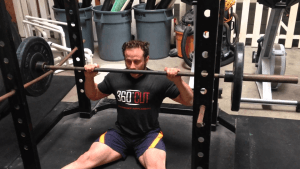 A Z press is a great assistance pressing movement as demonstrated by Kalle Beck
A Z press is a great assistance pressing movement as demonstrated by Kalle BeckEveryone has an opinion about how much to do, when to do it or even if it’s necessary especially since strongman has such a wide variety of overlapping competition movements.
Garage Gym Life has some awesome contributors who make this site a great resource for home based athletes. But I freely admit that we don’t know everything. So I scour the web to find the best articles from yesterday and today (I’d get them from the future as well but the DeLorean is in the shop) and bring you the links here. Starting Strongman founder Kalle Beck has some easy to follow guidelines to help you unravel the assistance exercise Gordian knot. Click the link to read more!
Source: Picking The Right Assistance Exercises (Video) – Starting Strongman
The post Assistance Exercises for Strongman: Picking The Right Ones For You appeared first on Garage Gym Life.
John Greaves III's Blog
- John Greaves III's profile
- 1 follower






